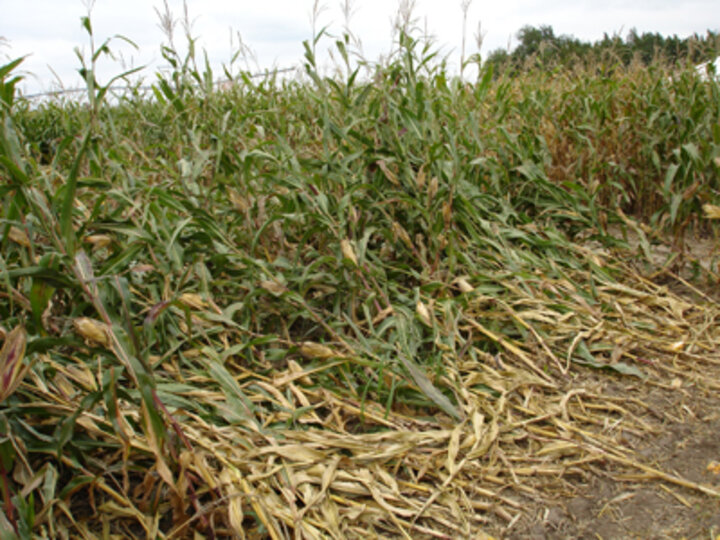May 23, 2008

|
| When planting shallow, the seed-vee may not properly close. This may lead to drying of the seed zone or allow pesticides to reach the germinating seed. |
Insects, Herbicides May be Wrongly Blamed
This spring presented less than ideal conditions for planting corn in many areas. With the cool weather, some producers may have decreased planting depths in an effort to facilitate quicker emergence. However, soil temperature and soil moisture are less buffered at shallow planting depths than at deeper ones and resulting stands may be less uniform in emergence. A number of problems can develop due to shallow planting and some can mimic insect and herbicide injury. Identifying the actual cause can aid in management and decision-making.
Planter Mechanics and Shallow Planting
Most corn planters were designed to plant 2 to 3 inches deep, so the plant develops a good root system. When planting shallower than that, especially when using a planter with angled closing wheels, producers risk sidewall compaction as the press wheels compact the soil below the seed rather than around the seed. (See the CropWatch story, Avoiding Sidewall Compaction at Planting - Don't Plant Too Shallow) Also, when planting shallow, the press wheels may not properly close the seed-vee, allowing it to dry out, affecting germination or root development. Problems may be blamed on insects or herbicide injury, but actually result from planting, so scout carefully to determine the true causes of problems.

|
| Injury typical of seedling growth inhibitors (metolachlor, alachlor, acetochlor, dimethenamid, flufenacet): Swollen shoots or improper leaf unfurling (buggy whipping). |

|
| Injury typical of pigment inhibitors (isoxaflutole, mesotrione): Bleaching or chlorosis of plant tissue. |
Herbicide Injury Potential
Injury potential from pre-emergence herbicides may be higher where inadequate seed furrow closure occurs. In this situation, herbicide may contact the germinating seed or be washed into the seed furrow. Scout for emergence problems where seedling growth inhibitors or pigment inhibitors were applied (Dual II Magnum, Harness, Surpass, Balance, Define, and many other products). Cool, wet conditions also can reduce a plant's ability to metabolize these herbicides, exacerbating injury.

|
| This planting depth demo plot was sprayed with a growth regulator herbicide at the V8 growth stage, later than labeled. The rows were planted at 1 inch, 1.75 inches, 2.5 inches, and 3.25 inches, from front to back, respectively. Standability improved with the better root systems developed with deeper planting. |

|
| If the soil surface is hot and dry when the nodal roots are developing, rootless corn syndrome may develop if the corn was planted too shallow. |
Poor Nodal Roots
Even after corn has emerged, root development problems may occur due to shallow planting, but be blamed falsely on insect feeding. As an example, the nodal roots develop about an inch above the seed or when the emerging shoot senses daylight, about 1 inch below the soil surface. When corn is planted too shallow, these nodal roots will form right at the soil surface. If the soil surface is hot and dry, the nodal roots don't develop properly, sometimes resulting in rootless corn syndrome. A timely rain or irrigation will help roots develop and the corn straighten. Planting deeper can alleviate this problem because the roots will develop in moist soil.

|
| Rootworm feeding is characterized by dark feeding scars on the roots as well as roots that have been chewed off. |
Avoiding the Problem
Producers can minimize many of these problems by simply planting deeper. A deeper seed depth allows a better root system to develop, with more nodal roots below the soil surface. When scouting poor stands or standability problems, producers must carefully observe the planting depth and effective root development.
Remember that what happens at planting can have an impact throughout the growing season. It is important to scout now, note any issues, and make management decisions that will minimize potential problems later in the season.
Lowell Sandell
Extension Educator, Weed Science
Paul Jasa
Extension Engineer
Keith Jarvi
Extension IPM
